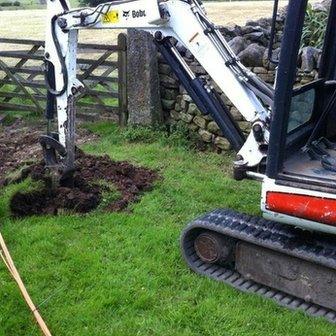Rural broadband: How the money will be spent
- Published

Some communities are digging their own networks
The UK government has announced how £250m set aside to improve broadband services in remote areas will be spent.
The money will be divided between local councils and each will have a month to work out how they will spend it to ensure superfast broadband is available to the majority of homes.
Critics have urged councils to consider providers other than BT, which has so far won all rural broadband contracts.
The government has been criticised for how it has handled the rollout so far.
It has invested £1.2bn in rural broadband and the Department for Culture, Media and Sport (DCMS) is hoping that the extra £250m will ensure 95% of the country's homes and businesses have access to superfast broadband by 2017.
Superfast broadband is defined by the European Union as broadband with speeds of 24Mbps (megabits per second) or above.
England will get the lion's share of the funds - £184m while Scotland will get £21m, Wales £12m and Northern Ireland just over £7m.
"We want to make sure that Britain is one of the best countries in the world for broadband," said Culture Secretary Maria Miller.
But the process to allocate the funds is likely to be watched very closely following harsh criticism of the way her department dished out the last round of funding.
A damning report from the Commons Public Accounts Committee (PAC) accused the government of ripping off taxpayers by handing all the money to BT.
It also accused the telecoms firm of exploiting its "quasi-monopoly" position and called for far more transparency on how it intended to spend the money.
More recently the PAC called on BT to provide detailed coverage maps that would allow alternative operators to offer services in areas the telecoms firm would not reach.
Infrastructure project
Malcolm Corbett, head of the Independent Network Co-operative Association, which represents some of the smaller community-based broadband suppliers, welcomed the new investment but made a plea for smaller community schemes to be recognised.
"There are a lot of independent suppliers who can offer a much better deal for the taxpayer," he said.
"Some of the alternatives to BT require far less state aid and they are offering fibre to the home which is a future-proofed technology meaning bandwidth ceases to be an issue," he said.
BT denies that it does not represent good value for money.
"We wouldn't accept that community schemes represent better value for money," said a spokesman for the telecoms firm.
"This a huge national infrastructure project rather than a community broadband scheme and it's proving to be an overwhelming success for the massive numbers of people that are being connected."
Poacher turns gamekeeper
Since BT signed contracts with councils around the UK, the plug has been pulled on several community-based schemes.
Barry Forde is chief executive of B4RN (Broadband for the Rural North). His community broadband service offers speeds of up to 1Gbps to around 350 homes currently. It costs £30 per month.
"All the projects that UK councils have signed with BT have killed off community broadband projects and they really need to make sure that doesn't happen this time around," he said.
"Councils need to be clear about exactly what they want to achieve and not just talk to BT about what it will give them. That is too much like the gamekeeper asking the poacher," he added.
He added that he was concerned that councils lacked the technical expertise to determine the best technology for rural residents.
The fibre-to-cabinet technology that is used by BT will not be "fit for purpose" in remoter areas because the speed of the service is so dependent on how far homes are from telephone cabinets, he said.
Mr Forde is also sceptical that the UK can reach its target of 95% fast broadband coverage by 2017.
He has personal experience of how the statistics can be misleading. He lives in the village of Quernmoor in Lancashire which, according to official figures, already has next-generation broadband access.
But in reality at least 10 homes in the village can only get speeds of 2Mbps or less.
"There are plenty of people who will be ticked off as having next-generation access but they won't have it," he said.
"My guess is that the promises of up to 97% coverage will actually amount to 70% of properties that can actually get speeds of 24 megabits or more," he said.
- Published12 November 2013
- Published22 January 2014
- Published16 January 2014